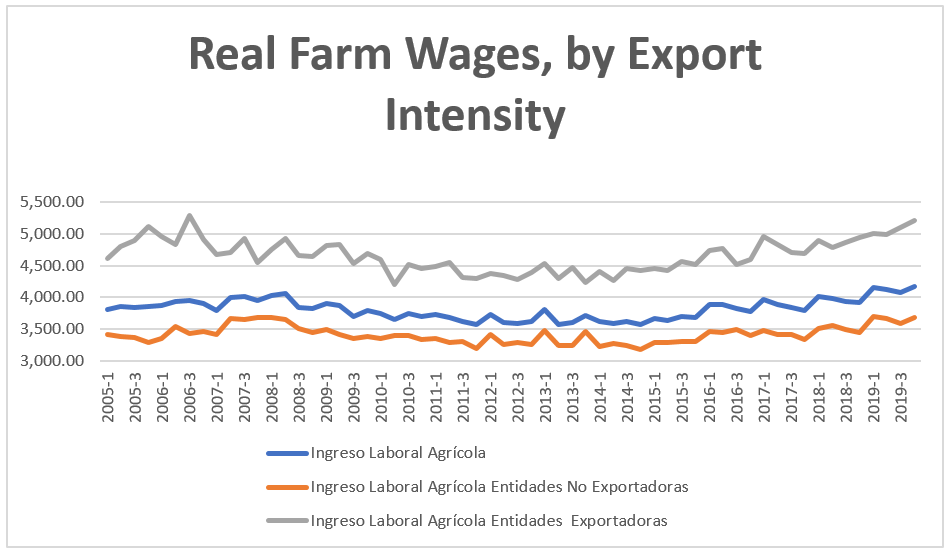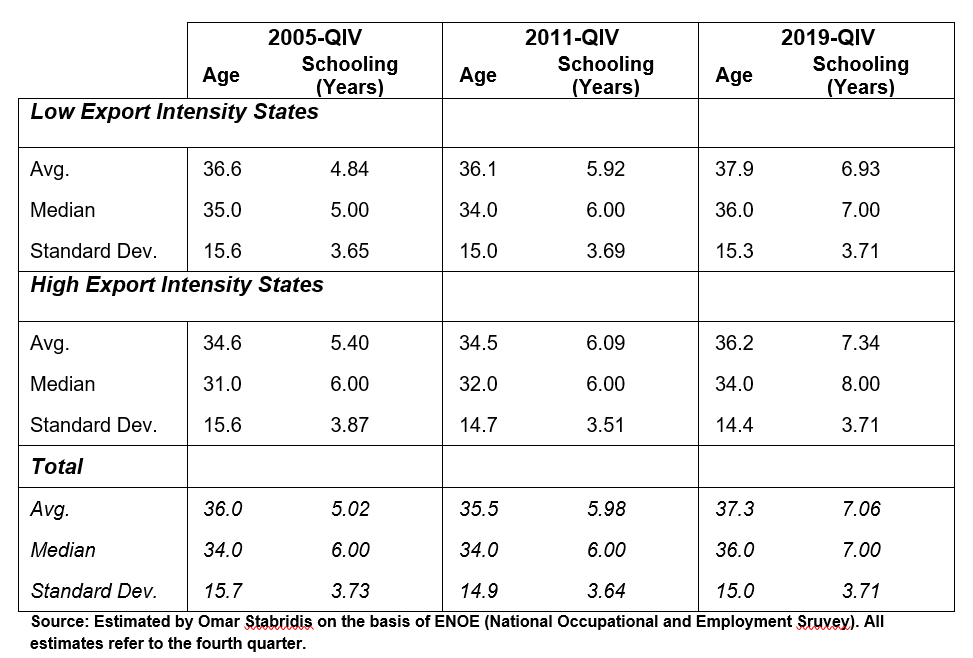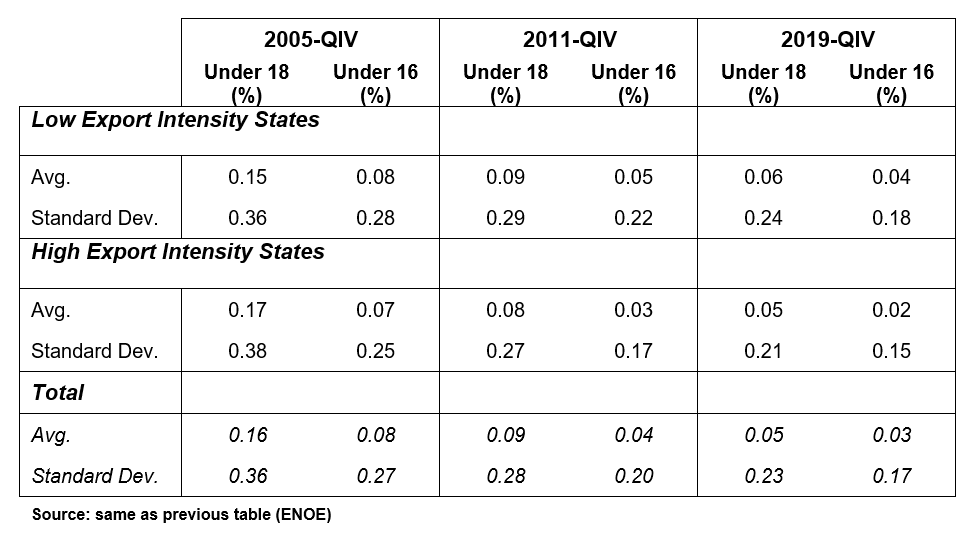Mexico’s Farming Society Over Time
Mexico’s farming sector has played a central role in the country’s history. During the Colonial Period, Mexico’s agriculture fed its population and supplied food, hides, and other inputs to mining, the export economy’s key activity.
During Mexico’s early independence, export agriculture diversified, with significant growth in the production of sugar, sisal, cacao and chocolate, coffee, and other products. Mexico’s land tenure system comprised Haciendas, ranches, and plantations producing for Mexican cities and for export, and community and smallholders producing mostly for subsistence. Conflict over land for export agriculture and mining pitted landowners against indigenous communities and small holders, with significant unrest and rebellion in Yucatán, Morelos, Oaxaca, and Chiapas. Land reform after 1857 took land away from indigenous communities and the catholic Church, intending to create land and labor markets to trigger growth in agricultural production. Towards the end of the XIX Century, the government’s decision to deed large land holdings – that had been settled by migrants from Central Mexico and the U.S. - in Northern Mexico to American firms was one of the factors triggering significant rural revolts, and the Mexican Revolution.
After Mexico’s revolution (1910 – 1921), very significant land redistribution took place, with 55% of Mexico’s land area passing to ejidos, a form of land tenure redesigned in the 20th Century. Ejidatarios were granted the use and inheritance of a parcel of land within a community holding, but they were not able to sell it, nor to use it as collateral. Many communities that had lost their land during the liberal reform of 1857 regained their land, but under the new form of ejidos, meaning their right to the land was strictly regulated by the government.
Land reform, ejidos, and Mexico’s food production, export, and distribution system have been criticized for providing little impetus for growth after the revolution. However, Mexico’s agriculture played a significant role in the XX Century, when urbanization and industrialization became the leading forces in development. During Mexico’s most feverish period of urban growth, from 1930 to 1980, Mexico’s agriculture furnished both the workers and the crops to feed Mexico’s expanding urban growth. In that sense, Mexico possessed a successful agricultural sector. Until 1974, Mexico exported surplus cereals to the US and other markets. Large growers benefited from very significant investment in dams, roads, railroads and other infrastructure. By 1970, growers in Sinaloa, Tamaulipas, and Jalisco produced irrigated maize with yields comparable to those in the US. A large productivity gap expanded between these large, well-equipped farms and the vast majority of the farming units, whose own production was insufficient to sustain a family for a year.
The government also played key roles in the development of new and better seeds and crops. The “Green Revolution” operated in Mexico through two competing agricultural development institutes, both belonging to the government, and in the production and distribution of fertilizers. Around 1970, both the main producer of fertilizers, and the main producer of cereal seeds, were government companies.
After 1974, however, Mexico’s agriculture began to lag behind. Production rose slowly, imports were required to meet consumption, more credit was granted to (larger) farmers, the government managed a subsidized system (CONASUPO) buying crops from farmers at guaranteed prices and selling them through its own urban distribution network at subsidized prices. While a money-losing system made sense as long production kept rising and imports were very low, the increasing cost of imports, and an increasing systematic deficit led to a new fundamental restructuring of the system in the late eighties.
Mexico’s agricultural development bank (BANRURAL) essentially stopped operating in 1988. The seed and fertilizer firms were privatized. In 1992, a constitutional reform was approved, granting ejidatarios and community landholders a path to the privatization, collateralization, rent and sale of their land. CONASUPO stopped operating, meaning both the sale of crops and the purchase of food in cities was increasingly left to market forces and private firms.
Mexico’s farm export boom took off rapidly since 2008. Our literature research and our case studies of firms, growers and regions show, however, that Mexican commercial firms have been innovating since the mid-1990’s. This includes significant foreign investment. Today, most of Mexico’s best irrigated land is devoted to highly productive agriculture, whether for export or for domestic consumption. This land includes ejido plots, as well as private property.
Mexico’s Farm Workers and Poverty
Mexico’s farm employment (the sum of agriculture, cattle husbandry, forestry, hunting and mining, and the sum of employers, employees, self-employed and unpaid labor) as a share of the total fell from 71.4% in 1921 to 58.3 in 1950, to 25.8% in 1980 and 13.4% in 2010. This past century was one of very accelerated urbanization, and thus it is understandable that Mexico’s farm workforce became a small minority of the total.
It is harder to establish the dynamics of wage labor itself, because the 1921 census did not distinguish the occupations in which persons received a wage as their only payment for work. The derogatory term for somebody who performs almost any kind of unskilled labor, but mainly a farming one, in the 1921 census was “gañanes”, and by themselves they accounted for 56% of Mexico’s entire workforce. At the time, then, most of Mexico’s labor force was classified as performing unskilled labor in the farming sector.
The overall trend in the farm labor force has been away from a reliance on family labor and the produce of one’s own plot. Traditionally, poverty has been more widespread and deeper in rural areas to the extent that, in diagnostics of poverty in Mexico carried out in the eighties, poverty was treated as a specifically rural phenomenon.[1]
Poor rural families have increasingly relied on wage work for their income, but both social policy transfers, and the dearth of wage employment in rural areas, mean that they don’t derive most of their income from wages. And that wage income does not derive mostly from farm work. As a number of sociologists have remarked, Mexico’s rural areas have become significantly urbanized. Most wage jobs in rural areas are found in commerce, the services and manufacturing, with waged farm work becoming one of several options. Mexico’s poorest decile (which corresponds to the households of farm workers), although increasingly relying on wages, is the least dependent of all Mexican households on wage income. In the poorest decile, only 38% of household income is from wage labor. In the second poorest decile, wages provide most of all income, with 53.8%. All deciles above that rely mostly on wages and salaries for the bulk of their income.
Rural wages follow a “U” shape from 2005 to 2019. From 2007, they fall until 2012, when they bottom and stagnate for about two years. In my opinion this fall is due to the Great Recession in the US, falling international labor emigration, and a relative abundance of rural labor in Mexico. Starting in 2015, however, they rise rapidly, until they reach their 2007 level by 2019. Figure 1 shows these wages, in 2018 pesos. The top line refers to states with “high export intensity”, the bottom line to states with “low-export intensity”, and the middle line is the national average.

The other large income source is transfers. Mexico’s poorest decile receives almost as much from transfers as it receives from wages (34.1%). This percentage falls to 23.5% in the second decile, and all deciles above received a smaller fraction of their total income from transfers. This means the ensemble of government transfers did benefit the poorest households the most. The vast majority of transfer flows were sent by the government through a variety of social programs: PROGRESA-OPORTUNIDADES_PROSPERA was the largest one. This program alone diminished income poverty in Mexico by 3%, and had a large impact on the reduction of the poverty income gap and on inequality among the poor. “POP” as it came to be known, had a payroll of 6.5 million households, and an approximate total of 26 million individuals. But there were a number of other programs: programs providing a per surface transfer provided the household grew certain crops (PROCAMPO), a large non-contributive pension programs for the elderly (70 +), a small program providing a minimum income to workers willing to be employed full time doing maintenance and repairs to rural infrastructure, and many other similar ones.[2]
The other significant source of transfers is international and national migration. International migration was never “targeted” to the poor, and if anything, it became less and less related to the poor, since international migration became an increasingly expensive enterprise. Nevertheless, it did have an effect on poverty reduction because, even though only a small fraction of all international transfers arrived at poor households, the size of the flow was so large that, for those poor households receiving remittances, this income source accounted for over 50% of their total income.
National remittances, on the contrary, are mostly sent by working members of poor rural households who are away temporarily, and they are in fact aimed at the poorest households. Most of the migrant farm workers we surveyed report they send remittances to their families. Many poor Mexicans send money to other poor Mexicans via banking cards and convenience stores. In addition to farm workers, domestic workers in Mexican cities also send money home, and there are many other similar flows.
Recent Changes in Mexico’s General Farm Workforce
Mexico’s population with an agricultural occupation comprises waged workers (farmworkers), persons working on their own account (mostly persons working on their land or on rented land, or peasants), persons working without a wage (mostly family members of someone who owns or rents land), and employers.
From 2010 to 2015, Mexico’s Census[3] reports significant changes among Mexico’s population devoted to farming. When comparing the 2010 census and the 2015 intercensus survey, the most significant changes are as follows:
- The total population working in agriculture diminishes.
- The absolute number and relative proportion of those working for a wage increases.
- The fall is accounted for mostly by falls in the number of those working on their own account and unpaid family workers.
Among women, the main changes are as follows:
- The total number of women reporting farm work as their main occupation, already a small proportion of the total in 2010, falls further in 2015.
- The share of women who report working for wages in agriculture rises from 45.6 to 69.3, and from 217,000 to 254,000.
- The share of women reporting working on their own account (mostly their own land) falls from 25 to 15%, and from 1.2 million to 550 thousand.
- The share of women reporting working without a wage falls from 26 to 13%. In absolute numbers this goes from 124,000 to 49,000.
Changes among men are less marked but they move in the same direction.
- The proportion of men working for wages rises from 45 to 54%, and from 2.37 to 2.5 million.
- Men working on their own account fall from almost 2 million to 1.18 million, and from 35 to 28% of the total.
- Finally, men working in agriculture without a wage increase from 13 to 17% of the total.
In summary, when one considers the entire population performing some kind of work in agriculture, it becomes evident that the trend from 2010 to 2015 is for that population to diminish in general, but also to become much more purely waged. The fact that women working in agriculture are more prone to collect wages suggests an improvement, both in terms of their possession of a personal income and because this means their households increase their total income.
Nevertheless, the census and the intercensus survey stop in 2015, so change since that date can’t be analyzed in those sources. To explore the waged farm workforce and analyze changes taking place until 2019, we use the National Occupation and Employment Survey (ENOE). Our analysis is based on a very large database developed by this project with 60 microdata sets comprising 2005 to 2020.
Recent Changes in the Waged Farm Work Force
Mexico’s ENOE is a quarterly survey of all Mexican workers. It centers on employment, and therefore offers a very good representation of waged and salaried workers.
From 2005 to 2019, the total number of waged workers has expanded. We divide them according to the participation of each state in total farm exports. States with the largest farm exports are classified under “high export intensity”. The rest under “low export intensity”. This is an approximation only, since the employment survey does not record whether a person works for export or not.
Table 1. ENOE: Total Number of Farmworkers in Export and Non-Export States, 2005 - 2019

Source: All ENOE tables have been prepared by Omar Stabridis from original microdata sets.
Table 1 shows the waged farm worker population is rising. It is rising faster in high export intensity states (49% vs. 39%). Nevertheless, it is worth pointing out that numbers are also rising in other states.
From the 2006-2008 period to the 2017-2019 period, total Mexican horticultural production increased from 30 to 40 billion tons, with half the increase exported to the US, and a sizable portion of the rest sent to other export markets. The high export intensity states are Michoacán, Guanajuato, Jalisco, Sinaloa, Sonora, and Baja California. Exports, however, are growing from states not in the traditional export zone. Exports from states such as San Luis Potosí, Puebla, Zacatecas, Tamaulipas, Baja California Sur and Veracruz have surged, often relatively faster than those from traditional export areas (Zahniser, 2020[4]).
The next table refers to age and schooling. Farm work has been Mexico’s occupation for workers with low or no schooling. Over the 15-year period in the table, the average schooling of farm workers has increased by about two years. Schooling has always been higher in the traditional export states. But it is women in farm work in non-traditional export states that have made the biggest gains in schooling, from 4.55 to 7.04 years. From 1997 and until 2018, the government implemented a program[5] aimed at the advancement of schooling among Mexico’s poorest families, and girls in particular. Evaluations found significant impacts of this program on schooling, and particularly on girls’ schooling. In export areas, women in farm work have higher schooling than men.
Farm workers in Mexico have aged only slightly. While in the US the Mexico – born farm workforce is 42 years old on average and aging rapidly, in Mexico the average age is only increasing slightly by about one and a half years over the 15 years in the table.
Table 2. Farm Workers' Age and Schooling, 2005-2019

On the basis of the same survey, we estimate the changing incidence of child labor from 2005 to 2019. We estimate both the incidence of minors in general, and of children under 16. Although the legal working age in Mexico is 16, the law defines certain occupations as unsafe for minors. This is the case of agriculture. The percentage of minors in general drops from 16% to 5% over these 15 years. In high-intensity export areas the fall is slightly more marked. Remember there can be export jobs in non-export states, and viceversa. In the case of children under 16 the difference between the two regions is a more marked, with low-intensity states halving the share of under 16s, and high-intensity states managing to reduce that share from 7 to 2 percent. Still, both kinds of underage labor are found in both regions, with only slightly better conditions in “high export intensity” regions.
Table 3. Farming Sector Child Labor 2005-2019

There are a number of developments that need to be monitored closely in the following years:
- Waged income rose among Mexico’s poorest rural households, mostly in export but also in non-export regions, and this reduced rural poverty.
- In the export sector, our survey (not analyzed in this report) shows even higher wages than the ones in ENOE, and almost universal compliance with benefits prescribed by the Federal Labor Law. Both these wage levels and compliance with benefits need to be monitored.
- Nevertheless, Mexico’s poorest rural households also depend on transfers. Since the social programs carrying out the transfers were completely restructured, it is important to monitor the new programs to ascertain to what extent they are also correctly aimed at the poorest households, or at least that the poorest households are not excluded.
- An initiative placing caps on banking commissions for transfers and other operations was first submitted in Mexico’s congress, then hastily withdrawn. Mexico’s poorest wage workers are already deep in debt, and, proportionately speaking, they pay the highest commissions of any social group. This is the case for their internal remittances, and for payday loans. It is extremely important to monitor that debt and banking commissions do not absorb a significant part of their income.
- Finally, rural wages increased very significantly from 2015 onwards. What the COVID epidemic will do to wages is unknown, but if demand drops production, employment, and real wages are bound to fall.
[1] This approach was correct in the sense that waged work grew very rapidly in urban areas, where income was also substantially higher. Starting in 1982, however, employment and income growth stagnated in urban areas, thus shifting attention to urban poverty.
[2] Mexico’s new government taking office in December 2018 restructured transfer programs substantially. Most of the programs described here don’t exist anymore, and they have been replaced by other transfer programs, less strictly targeted to the rural poor.
[3] These estimates are based on Mexico’s 2010 Population census, and on the 2015 Intercensus Survey. Both are carried out and published by INEGI.
[4] Zahniser, Stephen (2020) “Changes in Commodity Composition and Location of Mexican Horticultural Production” Paper delivered at LASA 2020.
[5] The program was initially called PROGRESA. It was renamed Oportunidades and, later, Prospera. It provided basic grants and scholarships to individuals in poor households, provided they attended school and received regular check-ups in public health clinics.
Author

Professor, CIESAS Occidente; Director, Jornaleros en la Agricultura Mexicana de Exportación

Mexico Institute
The Mexico Institute seeks to improve understanding, communication, and cooperation between Mexico and the United States by promoting original research, encouraging public discussion, and proposing policy options for enhancing the bilateral relationship. A binational Advisory Board, chaired by Luis Téllez and Earl Anthony Wayne, oversees the work of the Mexico Institute. Read more

Explore More
Browse Insights & Analysis
360° View of How Southeast Asia Can Attract More FDI in Chips and AI


